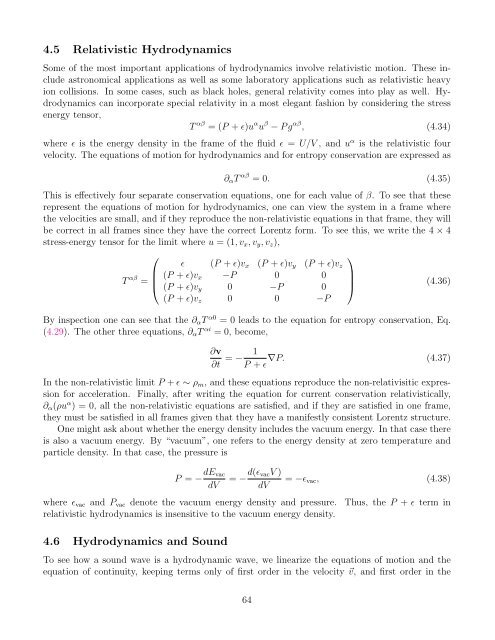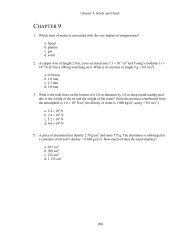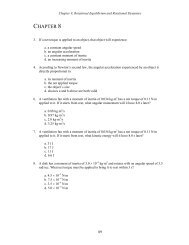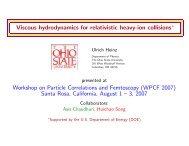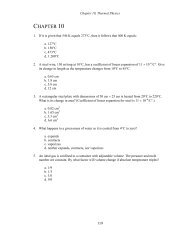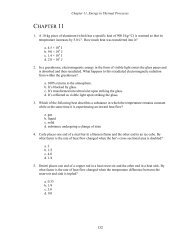lecture notes on statistical mechanics - Scott Pratt - Michigan State ...
lecture notes on statistical mechanics - Scott Pratt - Michigan State ...
lecture notes on statistical mechanics - Scott Pratt - Michigan State ...
Create successful ePaper yourself
Turn your PDF publications into a flip-book with our unique Google optimized e-Paper software.
4.5 Relativistic HydrodynamicsSome of the most important applicati<strong>on</strong>s of hydrodynamics involve relativistic moti<strong>on</strong>. These includeastr<strong>on</strong>omical applicati<strong>on</strong>s as well as some laboratory applicati<strong>on</strong>s such as relativistic heavyi<strong>on</strong> collisi<strong>on</strong>s. In some cases, such as black holes, general relativity comes into play as well. Hydrodynamicscan incorporate special relativity in a most elegant fashi<strong>on</strong> by c<strong>on</strong>sidering the stressenergy tensor,T αβ = (P + ϵ)u α u β − P g αβ , (4.34)where ϵ is the energy density in the frame of the fluid ϵ = U/V , and u α is the relativistic fourvelocity. The equati<strong>on</strong>s of moti<strong>on</strong> for hydrodynamics and for entropy c<strong>on</strong>servati<strong>on</strong> are expressed as∂ α T αβ = 0. (4.35)This is effectively four separate c<strong>on</strong>servati<strong>on</strong> equati<strong>on</strong>s, <strong>on</strong>e for each value of β. To see that theserepresent the equati<strong>on</strong>s of moti<strong>on</strong> for hydrodynamics, <strong>on</strong>e can view the system in a frame wherethe velocities are small, and if they reproduce the n<strong>on</strong>-relativistic equati<strong>on</strong>s in that frame, they willbe correct in all frames since they have the correct Lorentz form. To see this, we write the 4 × 4stress-energy tensor for the limit where u = (1, v x , v y , v z ),T αβ =⎛⎜⎝ϵ (P + ϵ)v x (P + ϵ)v y (P + ϵ)v z(P + ϵ)v x −P 0 0(P + ϵ)v y 0 −P 0(P + ϵ)v z 0 0 −P⎞⎟⎠ (4.36)By inspecti<strong>on</strong> <strong>on</strong>e can see that the ∂ α T α0 = 0 leads to the equati<strong>on</strong> for entropy c<strong>on</strong>servati<strong>on</strong>, Eq.(4.29). The other three equati<strong>on</strong>s, ∂ α T αi = 0, become,∂v∂t = − 1 ∇P. (4.37)P + ϵIn the n<strong>on</strong>-relativistic limit P + ϵ ∼ ρ m , and these equati<strong>on</strong>s reproduce the n<strong>on</strong>-relativisitic expressi<strong>on</strong>for accelerati<strong>on</strong>. Finally, after writing the equati<strong>on</strong> for current c<strong>on</strong>servati<strong>on</strong> relativistically,∂ α (ρu α ) = 0, all the n<strong>on</strong>-relativistic equati<strong>on</strong>s are satisfied, and if they are satisfied in <strong>on</strong>e frame,they must be satisfied in all frames given that they have a manifestly c<strong>on</strong>sistent Lorentz structure.One might ask about whether the energy density includes the vacuum energy. In that case thereis also a vacuum energy. By “vacuum”, <strong>on</strong>e refers to the energy density at zero temperature andparticle density. In that case, the pressure isP = − dE vacdV = −d(ϵ vacV )dVwhere ϵ vac and P vac denote the vacuum energy density and pressure.relativistic hydrodynamics is insensitive to the vacuum energy density.4.6 Hydrodynamics and Sound= −ϵ vac , (4.38)Thus, the P + ϵ term inTo see how a sound wave is a hydrodynamic wave, we linearize the equati<strong>on</strong>s of moti<strong>on</strong> and theequati<strong>on</strong> of c<strong>on</strong>tinuity, keeping terms <strong>on</strong>ly of first order in the velocity ⃗v, and first order in the64


